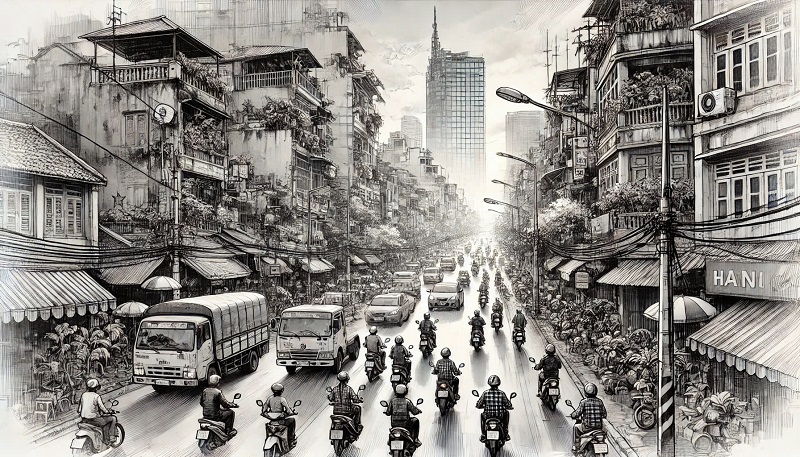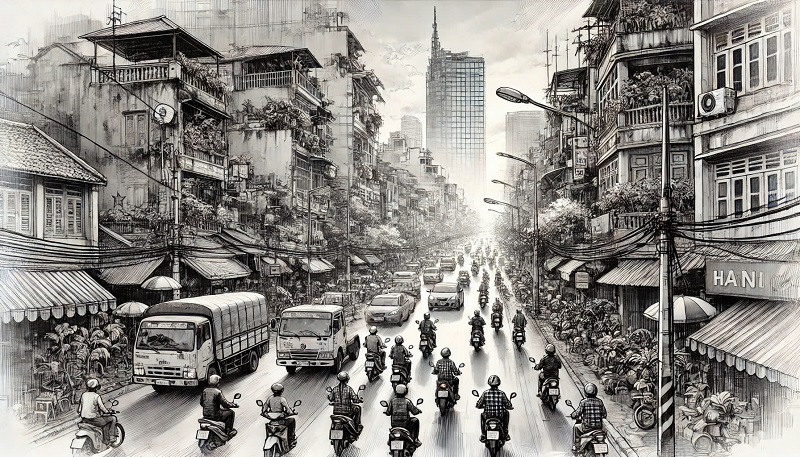
Hanoi is making strong steps to tackle air pollution, aiming to boost its appeal.
Hanoi's efforts to improve air quality are gaining momentum as the city announces plans for Low Emission Zones (LEZs) and a phased ban on private vehicles in busy areas. Since air pollution still has an impact on day-to-day living, these actions are meant to lower emissions and enhance the standard of living in the capital.
This week's Words on the Street feature in The Hanoi Times examines the potential effects of the LEZ program on locals, the practicalities of enforcing emission limits, and whether or not this scheme can make Hanoi a truly green, livable city for all.
 |
Enjoying traditional com (young sticky rice) under Hanoi's soft, pure autumn sunlight is a treat for the capital's urbanites this time of year. However, for some, their expectations may be spoiled by unwanted variables.
Lan Anh Le, a Hanoi local, shared on her Facebook profile the ordeal she went through to enjoy a Hanoi autumn day. Instead of spending a peaceful weekend at home with her family, she decided to take her children on the metro and then a taxi to Hanoi's Old Quarter to enjoy pho bo (beef noodles), com, and the autumn air.
But instead of finding the tranquility and purity that others had described, Lan Anh and her children felt suffocated by dust and fumes. After the outing, she could not help but vent her frustration on Facebook, lamenting the dust and pollution in Hanoi. Her post received about 11,000 likes, more than 1,100 comments, and 926 shares.
It was just one person's perspective, but the fact that it went viral shows how concerned Hanoians are about the quality of their air.
Today, many Hanoians are familiar with the sight of large, smoke-belching buses, old motorcycles spewing white clouds, and trucks carrying uncovered construction materials spreading dust across the city. These woes make the daily commute a nightmare, especially during rush hour - although it's hard to say what rush hour is in Hanoi, with traffic so dense from early morning until early midnight.
The Hanoi People's Committee recently released a draft resolution detailing the requirements, conditions, and procedures for establishing Low Emission Zones (LEZs) by the Capital Law of 2024. An LEZ is defined as a specific section of the city with high levels of air pollution. Vehicles entering the zone will be required to meet strict emission limits; those that do not will be subject to penalties or restrictions.
To define LEZs, five criteria have been established. First, areas with high population density, important economic, cultural, or social activities, sites in need of preservation, or cultural tourism potential. Second, places with high levels of air pollution from vehicles. Third, places that have the infrastructure to accommodate properly managed traffic and public transportation with low emissions. Fourth, areas that can adopt stricter vehicle emission standards, backed by mechanisms to track and enforce compliance, replace vehicles, and ensure efficient traffic flow. Finally, places where both residents and the government are supportive of LEZ development.
Along with the city government's goal to limit personal motorcycles in urban areas by 2030, this is a major attempt to make Hanoi a greener city.
The proposed LEZ policy will likely gain widespread support from Hanoians. It promises not only to improve residents’ quality of life and air quality but also to position Hanoi as a greener, more sustainable city globally.
Cities in Southeast Asia and China with narrow streets have long restricted personal motorcycles and implemented similar policies. Beijing banned internal combustion motorcycles in 1985, and Guangzhou followed suit in 2007. By 2020, 185 cities across China had banned motorcycles.
Reasonable evaluation is essential
Given the significant impact this strategy will have on social structures, it's important to be rational in enforcing it, in addition to looking at qualitative factors. For many people, restricting private vehicles - especially gas-powered motorcycles - will be a significant turnaround.
Hanoi currently has about eight million registered private vehicles, including 6.7 million motorcycles and 1.1 million cars. In addition, roughly 1.2 million cars frequently travel to the metropolis from neighboring provinces.
Motorcycles are an important source of income and a prized possession for many people. Hanoi's unique urban layout - with many narrow streets and alleys - makes motorcycles the most practical option for mobility.
If the use of private vehicles is restricted, residents will turn to alternative means of transportation, namely public transport. Despite the existence of two metro lines and numerous bus routes, there are still doubts as to whether Hanoi's current mass transit network will be able to meet this demand.
Furthermore, restricting motorcycles means that many residents will switch to electric bikes, which can be costly. An electric motorbike, fully furnished with a long-lasting battery, plenty of storage space, and safety features, typically costs at least VND20 million (US$800). Considering that Vietnam's average annual per capita income is about $4,700, this is remarkable.
If such a transition is mandated, who will pay for it? Will government agencies, organizations, or businesses step in to support residents, or will the financial burden fall entirely on individuals?
Furthermore, there must be broad public support for the establishment of LEZs and restrictions on private vehicles. To minimize unfavorable public attitudes and residents feeling unfairly blamed for emissions, the local government must propose a clear, comprehensive, and compelling plan.
Another concern is parking around the LEZs. Someone would have to park outside an LEZ if they wanted to enter but their vehicle didn't meet the emissions requirements. Will there be enough parking? Will there be sufficient mobility between high and low-emission zones?
This policy is commendable in the eyes of The Hanoi Times, but establishing LEZs by 2025 will be challenging, as will the goal of restricting motorcycles by 2030. However, with decisive, transparent, and trustworthy action from the city, residents are likely to support these efforts wholeheartedly.
Let's hope that this policy becomes feasible - not only for the lives of today's Vietnamese, especially Hanoians but also for future generations.